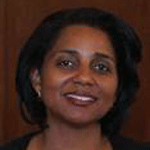Director, Publications, INFORMS
 First, tell us a bit about yourself (hometown, current locale, family, hobbies, community involvement?)
First, tell us a bit about yourself (hometown, current locale, family, hobbies, community involvement?)
I grew up in Indianapolis and moved to Baltimore with my family as a teenager. I now live in Baltimore with my husband Marquis, our sons, Nile and William, and our dog, Zoë. Work and family keep me pretty busy. I turn to knitting in the winter months and exercising outdoors in the spring and summer to give my mind and body a boost.
Describe some of your responsibilities, and how you or your organization fit into the scholarly communications web.
INFORMS is an association that supports professionals in analytics and operations research through meetings, special interest groups, career support services, and publications. We are unique to associations in that we handle the entire publishing process for our journals from peer-review to marketing to subscription management. It is my job to support and unite the amazing network of staff and volunteers that it takes to publish 13 of the most rigorous and highly ranked journals in management, applied mathematics, and operations research; this includes creating budgets, journal proposals, staff development, project management, and guiding the strategic direction for the publications. However, one of my favorite duties is to absorb and interpret the evolving world of scholarly publishing for the association.
What career path led to your current position?
As a teenager, I didn’t have a grand plan. While I knew what I enjoyed doing (reading and writing), I didn’t know how to translate that into a career. So, at 18, I joined the US Army. My thought was, I didn’t know what I wanted to be when I grew up, so if I join the army I’ll be helping my country while I figure it out. It didn’t take me long to decide I wanted to work in communications. The plan was to be a journalist, a broadcaster, producer, publisher, anything that kept me in the information distribution business.
After finishing the Army, I moved back to Baltimore and enrolled at Morgan State University. In my 23-year-old mind, I was going to be the next Barbara Walters or Oprah Winfrey. I did work in journalism for a couple of years but quickly narrowed my focus on being a managing editor. I wanted to manage the process but still be at the creative table. I went on to earn a Master’s degree from the University of Baltimore in publications design with a focus on publications management. After graduation, I came across an online job posting for an “assistant managing editor” at Johns Hopkins Hospital. While I thought it was odd that a hospital would need a managing editor, it looked interesting and the idea of working with smart people fascinated me. At that point I had no experience with the concept of peer review. My husband had just started working towards his PhD in molecular biology so the phrase “I need to get published” had not yet become a mantra in our home. Before the interview, I did some homework and ended up getting the job. The journal was owned by an association but published by a large commercial publisher. My first weeks on the job consisted of digging through mounds of boxes filled with hand written reviews and photocopies of articles. After a sore back and fingers full of paper cuts, I discovered a new work philosophy: “There has got to be a better way.”
My coworkers and I went on to migrate the journal to electronic peer review. My relationship with the folks at the commercial publisher grew along with my curiosity about journal production and the world of scholarly publishing. I then left Hopkins for a position as a journal production manager with a publishing services company. In a day, I went from being the client to being the vendor. It did not take me long to learn the challenges of offering intellectual services to the world’s leading intellectuals.
In 2006, I joined INFORMS as the journal production manager and went on to become the publications manager and now director. I was fortunate to be the handpicked successor of Patricia Shaffer, an active member of the scholarly publishing community. Pat was my mentor. She saw something in me and pushed me to look beyond production management to the “big picture” of scholarly publishing. The first time Pat sent me to an SSP meeting she walked in my office with the meeting’s program and directed me to “think outside the box and don’t just go to sessions where you already know the topic. Be willing to challenge yourself and learn about new aspects of publishing.” I have now been in this business for a decade and still thrive on how the challenges presented at the SSP annual meeting sessions empower publishers and librarians to move towards finding that “better way.”
Where do you see scholarly communications heading, and what new directions interest you most?
The innovations will keep coming. It may be a couple of years before the next iPad-like device or software but it will come and publishers will embrace it. Today, what interests me the most are the challenges facing authors as a result of open access mandates. Publishing is the bread and butter for academic promotion, and unlike medical and life scientist, the majority of authors in the social sciences do not have generous funders behind them. New open access mandates are threatening to push more publishers to move to and create author-pays models (aka, the gold standard). And, while I understand and respect the ideals behind the mandates, I have concerns about publishers being encouraged to move to a model that would create obstacles to publications for so many researchers. The subscription model that has supported the industry is at risk for crumbling. And, while the rubble may not hit the ground for publishers quick enough to establish article processing charges, it may fall on the backs of the authors who are the core of our business and add one more hurdle to their tenure tracks.
What are some of the surprises/obstacles that you’ve encountered during your career?
I am always amazed when I chat with a researcher who thinks it is free to post content on the Internet. While complaining about subscription cost, he or she often says “You are price gouging us!” I have to stop myself from climbing up on my soapbox and ranting on about the cost of labor, peer review, and online platforms.
My greatest obstacle in this business has been simply explaining what I do. My job title does not intrinsically define the breadth and scope of my work. That is why associations like SSP are so important. They bring together publishers and librarians who share a common mission to advance and disseminate the best research the world has to offer and allow us all to be a part of a community where (almost) everyone speaks the same language.
What advice would you give to people interested in a career in scholarly communications? What new roles or opportunities do you see emerging in the field?
I never met a college freshman with the ambition of being a scholarly publisher. But I have met plenty that love to read and write, and who want to know everything about everything. The good thing is that being able to digest and interpret information is the core of scholarly publishing. So, don’t just take in the chatter you read online and hear in journal clubs; study the path it took to get there. Who were the movers of that information? The Twitter feed, the blog, the newspaper, the reporter, the press release, the marketer, the librarian, the journal, the editor, the authors…. Get where I am headed? Then consider where in that process you see yourself.
Don’t lock yourself into a title. Ten years ago, there was no such thing as a social media manager. One of the most diverse roles in publishing today is that of a managing editor. For one publisher they manage peer review, while at another they are the single force behind of the entire publication process. Make time to look outside the box so you’ll be ready for the next big thing. Don’t be afraid to ask questions and offer ideas. Be willing to listen to advice and be grateful for it, even if you don’t agree. And remember that you are part of the information food chain that disseminates the innovation that nourishes the world.

